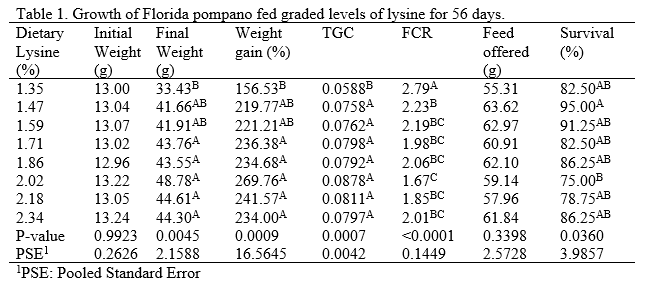DIETARY LYSINE REQUIREMENT FOR JUVENILE FLORIDA POMPANO Trachinotus carolinus FED FISHMEAL FREE DIETS
Alternative protein sources are implemented as a substitute or complement to fishmeal in order to improve feed sustainability. However, critical nutritional requirements such as indispensable amino acids are limited when alternative protein sources are added in aquaculture feeds. Lysine is often one of the first limiting amino acids in feeds formulated with high levels of plant proteins. Therefore, the objective of this study was to determine the dietary lysine requirement for Florida pompano, Trachinotus carolinus. In the trial, eight diets were prepared with increasing lysine inclusion levels from 1.35 to 2.34% of the diet. The feeding trial was conducted in a semi-closed recirculating system comprising of 36 circular tanks (750L) at Claude Peteet Mariculture Center. Twenty Florida pompano juveniles (mean weight = 13.07 ± 0.46 g) were stocked into each tank and assigned to quadruplicate tanks in a randomized design. Fish were fed 4 times per day and daily ration was adjusted to apparent satiation. Sampling of fish occurred every 2 weeks to adjust feed inputs for growth and mortalities. The growth trial lasted for 56 days. At the conclusion of the trial, fish were weighed and 4 fish per tank were euthanized in ice for measurement of whole-body composition analysis. Statistical analyses were conducted using SAS (V9.3 SAS Institute, Cary, NC). Initial weight, final weight, percent weight gain (PWG), thermal growth coefficient (TGC), feed conversion rate (FCR), feed intake and survival were analyzed using a one-way analysis of variance (ANOVA). Significance level was set at P<0.05. Results indicated that significant differences were observed amongst treatments for final weight, PWG, TGC, FCR and survival (Table 1). Means in a column with different superscript letters are significantly different according to Tukey's multiple range test (Table 1).
